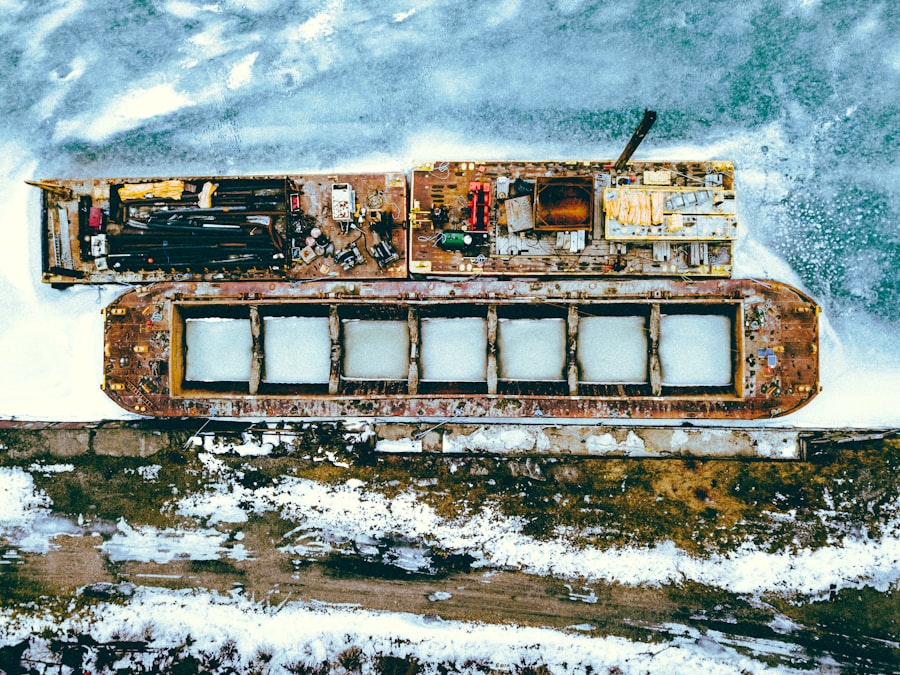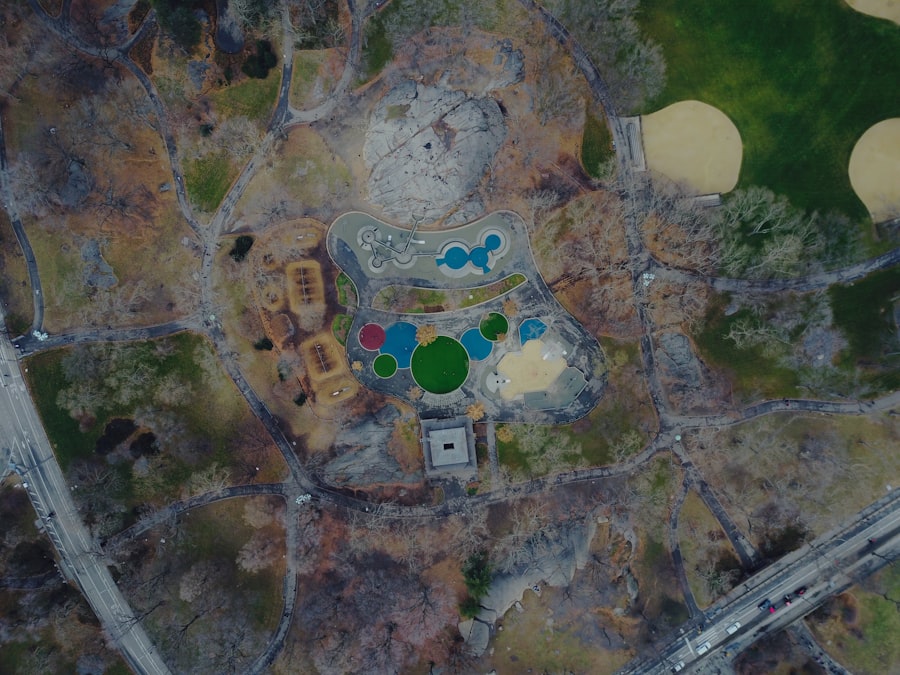The advent of autonomous drones has revolutionized various sectors, particularly in the realm of industrial facility monitoring. These unmanned aerial vehicles (UAVs) are equipped with advanced technologies that enable them to perform a multitude of tasks with minimal human intervention. In industrial settings, where safety, efficiency, and precision are paramount, the integration of autonomous drones has emerged as a game-changer.
They are capable of conducting inspections, monitoring equipment, and gathering data in real-time, thereby enhancing operational oversight and decision-making processes. The use of autonomous drones in industrial facilities is not merely a trend; it represents a significant shift in how industries approach monitoring and maintenance. Traditional methods often involve manual inspections, which can be time-consuming, labor-intensive, and fraught with risks.
In contrast, drones can access hard-to-reach areas, operate in hazardous environments, and provide high-resolution imagery and data analytics. This capability not only streamlines operations but also contributes to a safer working environment by reducing the need for personnel to enter potentially dangerous zones.
Key Takeaways
- Autonomous drones offer a cost-effective and efficient solution for monitoring industrial facilities, providing real-time data and reducing the need for manual inspections.
- The use of autonomous drones in industrial facility monitoring can lead to improved safety, reduced operational downtime, and enhanced security measures.
- Autonomous drones are programmed with advanced software and sensors to navigate and collect data in industrial facilities, allowing for precise monitoring and analysis.
- The role of autonomous drones in ensuring safety and security at industrial facilities includes identifying potential hazards, monitoring for unauthorized access, and responding to emergency situations.
- The impact of autonomous drones on efficiency and productivity in industrial facilities is significant, as they can quickly identify maintenance needs, monitor inventory levels, and streamline operations.
The Advantages of Using Autonomous Drones for Industrial Facility Monitoring
Reducing Risk in Hazardous Environments
Drones can be deployed in environments that pose significant risks to human workers, such as chemical plants or oil refineries. By utilizing drones for inspections in these hazardous areas, companies can mitigate the risk of accidents and injuries. For instance, drones can inspect storage tanks for leaks or structural integrity without requiring personnel to enter confined spaces.
Cost Savings through Efficient Inspections
In addition to safety improvements, autonomous drones offer substantial cost savings. Traditional inspection methods often necessitate extensive manpower and equipment, leading to increased operational costs. Drones can significantly reduce these expenses by performing inspections more quickly and efficiently.
Timely Maintenance Interventions
For example, a drone equipped with thermal imaging can identify heat anomalies in electrical systems much faster than a human inspector could. This rapid identification allows for timely maintenance interventions, ultimately saving money by preventing costly downtime or catastrophic failures.
How Autonomous Drones are Programmed to Monitor Industrial Facilities

The programming of autonomous drones for industrial facility monitoring involves sophisticated algorithms and software that enable them to navigate complex environments autonomously. These drones are typically equipped with GPS technology, sensors, and cameras that allow them to gather data while flying predetermined paths. The programming process begins with the creation of a flight plan that outlines the specific areas to be monitored, the type of data to be collected, and the frequency of inspections.
Advanced machine learning techniques are often employed to enhance the drone’s capabilities further. For instance, drones can be trained to recognize specific patterns or anomalies in the data they collect. This training process involves feeding the drone vast amounts of data so that it can learn to distinguish between normal operational conditions and potential issues that require attention.
As a result, these drones become increasingly adept at identifying problems over time, leading to more effective monitoring and maintenance strategies.
The Role of Autonomous Drones in Ensuring Safety and Security at Industrial Facilities
Autonomous drones play a critical role in enhancing safety and security within industrial facilities. Their ability to conduct regular inspections helps identify potential hazards before they escalate into serious incidents. For example, drones can monitor gas emissions or detect leaks in pipelines, allowing for immediate corrective actions that prevent environmental disasters or workplace accidents.
This proactive approach not only safeguards employees but also protects the surrounding community and ecosystem. Moreover, drones can be utilized for security surveillance around industrial sites. Equipped with high-definition cameras and thermal imaging capabilities, they can monitor perimeters and detect unauthorized access or suspicious activities.
This capability is particularly valuable in industries where theft or vandalism poses significant risks. By providing real-time surveillance data, drones enable security teams to respond swiftly to potential threats, thereby enhancing overall facility security.
The Impact of Autonomous Drones on Efficiency and Productivity in Industrial Facilities
The integration of autonomous drones into industrial operations has led to remarkable improvements in efficiency and productivity. By automating routine inspection tasks, companies can allocate human resources to more strategic roles that require critical thinking and problem-solving skills. This shift not only optimizes workforce utilization but also enhances overall operational efficiency.
Furthermore, the speed at which drones can perform inspections contributes significantly to productivity gains. Traditional inspection methods may require downtime for equipment or processes, leading to lost production time.
In contrast, drones can conduct inspections while operations continue unabated. This capability is particularly beneficial in industries such as manufacturing or energy production, where maintaining continuous operations is crucial for profitability.
Challenges and Limitations of Using Autonomous Drones for Industrial Facility Monitoring

Despite their numerous advantages, the deployment of autonomous drones for industrial facility monitoring is not without challenges and limitations. One significant hurdle is regulatory compliance. Many countries have stringent regulations governing drone operations, particularly concerning airspace restrictions and privacy concerns.
Navigating these regulations can be complex and may require companies to invest time and resources into obtaining necessary permits and ensuring compliance with local laws. Another challenge lies in the technological limitations of drones themselves. While advancements have been made in drone capabilities, issues such as battery life and payload capacity remain constraints.
For instance, many drones have limited flight times due to battery limitations, which can restrict their operational range and the duration of inspections. Additionally, adverse weather conditions such as high winds or heavy rain can impede drone operations, necessitating contingency plans for inspections during inclement weather.
Future Developments and Innovations in Autonomous Drones for Industrial Facility Monitoring
The future of autonomous drones in industrial facility monitoring is poised for exciting developments driven by technological advancements and increasing demand for efficiency. One area of innovation is the integration of artificial intelligence (AI) into drone systems. AI algorithms can enhance data analysis capabilities, allowing drones to not only collect data but also interpret it in real-time.
This advancement could lead to predictive maintenance strategies where potential issues are identified before they manifest into significant problems. Another promising development is the enhancement of drone autonomy through improved navigation systems. Future drones may utilize advanced sensors and machine learning techniques to navigate complex environments more effectively.
This capability would enable them to operate in challenging conditions without human intervention while ensuring safety and compliance with regulations. Additionally, advancements in battery technology could extend flight times significantly, allowing drones to cover larger areas without needing frequent recharging.
Case Studies and Success Stories of Autonomous Drones Monitoring Industrial Facilities
Numerous case studies illustrate the successful implementation of autonomous drones in monitoring industrial facilities across various sectors. One notable example is the use of drones by a major oil company for pipeline inspections. By deploying drones equipped with thermal imaging cameras along extensive pipeline networks, the company was able to detect leaks and anomalies much faster than traditional methods allowed.
This proactive approach not only reduced environmental risks but also saved millions in potential losses from undetected leaks. Another success story comes from the renewable energy sector, where wind turbine operators have begun using drones for routine inspections. Drones equipped with high-resolution cameras can quickly assess the condition of turbine blades from various angles without requiring scaffolding or cranes.
This method has significantly reduced inspection times while improving safety by minimizing the need for workers to climb heights during inspections. These case studies exemplify how autonomous drones are transforming industrial facility monitoring by enhancing safety, efficiency, and overall operational effectiveness across diverse industries. As technology continues to evolve, it is likely that we will see even more innovative applications of drones in this critical area.
If you are interested in technology and innovation, you may also enjoy reading about how TheNextWeb brings insights to the world of technology. This article discusses the latest trends and developments in the tech industry, providing valuable information for tech enthusiasts. Check it out here to stay updated on the exciting world of technology.
FAQs
What are autonomous drones?
Autonomous drones are unmanned aerial vehicles (UAVs) that are capable of operating without direct human control. They are equipped with sensors, cameras, and other technology that allows them to navigate and make decisions on their own.
How do autonomous drones monitor industrial facilities?
Autonomous drones can be programmed to fly over industrial facilities and use their sensors and cameras to monitor for various factors such as equipment malfunctions, leaks, security breaches, and environmental hazards. They can provide real-time data and imagery to help with monitoring and decision-making.
What are the benefits of using autonomous drones for industrial facility monitoring?
Using autonomous drones for industrial facility monitoring can provide several benefits, including cost savings, improved safety, increased efficiency, and the ability to access hard-to-reach or hazardous areas. Drones can also help with preventive maintenance and early detection of issues.
What types of industrial facilities can benefit from autonomous drone monitoring?
A wide range of industrial facilities can benefit from autonomous drone monitoring, including oil and gas refineries, chemical plants, power plants, manufacturing facilities, warehouses, and more. Any facility that can benefit from aerial monitoring and data collection can potentially use autonomous drones.
What are the limitations of using autonomous drones for industrial facility monitoring?
Some limitations of using autonomous drones for industrial facility monitoring include regulatory restrictions, limited battery life and flight time, weather conditions, and the need for skilled operators and data analysts. Additionally, there may be privacy and security concerns that need to be addressed.

